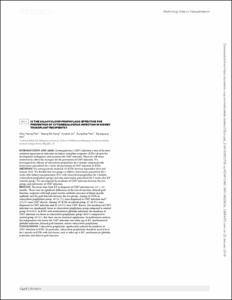KUMEL Repository
1. Journal Papers (연구논문)
1. School of Medicine (의과대학)
Dept. of Internal Medicine (내과학)
IS THE VALACYCLOVIR PROPHYLAXIS EFFECTIVE FOR PREVENTION OF CYTOMEGALOVIRUS INFECTION IN KIDNEY TRANSPLANT RECIPIENTS?
- Alternative Author(s)
- Kang, Seong Sik; Park, Sung Bae; Han, Seung Yeup; Park, Woo Young; Jin, Kyu Bok
- Journal Title
- Nephrology, Dialysis, Transplantation
- ISSN
- 0931-0509
- Issued Date
- 2017
- Abstract
- INTRODUCTION AND AIMS: Cytomegalovirus (CMV) infection is one of the most common opportunistic infections in kidney transplant recipients (KTRs) despite the development of diagnosis and treatment for CMV infection. There are still many controversies about the strategies for the prevention of CMV infection. We investigated the efficacy of valacyclovir prophylaxis for 3 months compared with intravenous ganciclovir for 2 weeks for prevention of CMV infection in KTRs.
METHODS: We retrospectively analyzed 153 KTRs between September 2013 and January 2016. We divided into two groups as follows: intravenous ganciclovir for 2 weeks after kidney transplantation (KT) with valacyclovir prophylaxis for 3 months (valacyclovir prophylaxis group) and only intravenous ganciclovir for 2 weeks after KT (control group). We investigated the incidence of CMV infection between the two groups and risk factors of CMV infection.
RESULTS: The mean time from KT to diagnosis of CMV infection was 4.8 ± 4.2 months. There were no significant differences in the rate of rejection, delayed graft function, recipients with high panel reactive antibody, presence of donor specific antibody, and the graft function between the two groups. Among 46 KTRs in valacyclovir prophylaxis group, 10 (21.7%) were diagnosed to CMV infection and 7 (15.2%) were CMV disease. Among 107 KTRs in control group, 47 (43.9%) were diagnosed to CMV infection and 26 (24.3%) were CMV disease. The incidence of CMV infection was significantly lower in valacyclovir prophylaxis group compared to control group (P=0.011). In KTRs with antithymocyte globulin induction, the incidence of CMV infection was lower in valacyclovir prophylaxis group (40.0%) compared to control group (67.6%), but there was no statistical significance. In multivariate analysis, the independent risk factors for CMV infection were older age at KT, antithymocyte globulin induction, delayed graft function, and no valacyclovir prophylaxis.
CONCLUSIONS: Valacyclovir prophylaxis significantly reduced the incidence of CMV infection in KTRs. In particular, valacyclovir prophylaxis should be used at least for 3 months in KTRs with risk factors such as older age at KT, antithymocyte globulin induction, and delayed graft function.
- Department
- Dept. of Internal Medicine (내과학)
- Publisher
- School of Medicine (의과대학)
- Citation
- Woo Yeong Park et al. (2017). IS THE VALACYCLOVIR PROPHYLAXIS EFFECTIVE FOR PREVENTION OF CYTOMEGALOVIRUS INFECTION IN KIDNEY TRANSPLANT RECIPIENTS? Nephrology, Dialysis, Transplantation, 32(suppl.3), p490–p490. doi: 10.1093/ndt/gfx158.SP818
- Type
- Article
- ISSN
- 0931-0509
- Appears in Collections:
- 1. School of Medicine (의과대학) > Dept. of Internal Medicine (내과학)
- 파일 목록
-
-
Download
 oak-2018-0655.pdf
기타 데이터 / 75.99 kB / Adobe PDF
oak-2018-0655.pdf
기타 데이터 / 75.99 kB / Adobe PDF
-
Items in Repository are protected by copyright, with all rights reserved, unless otherwise indicated.